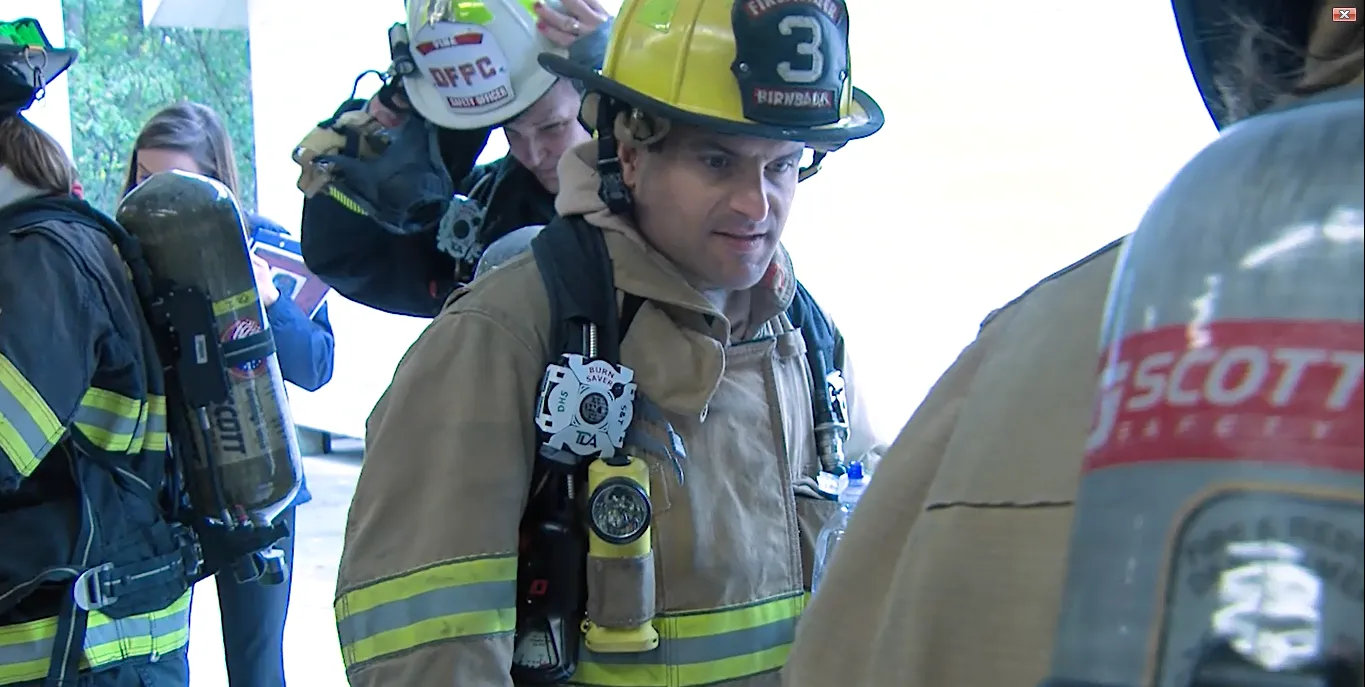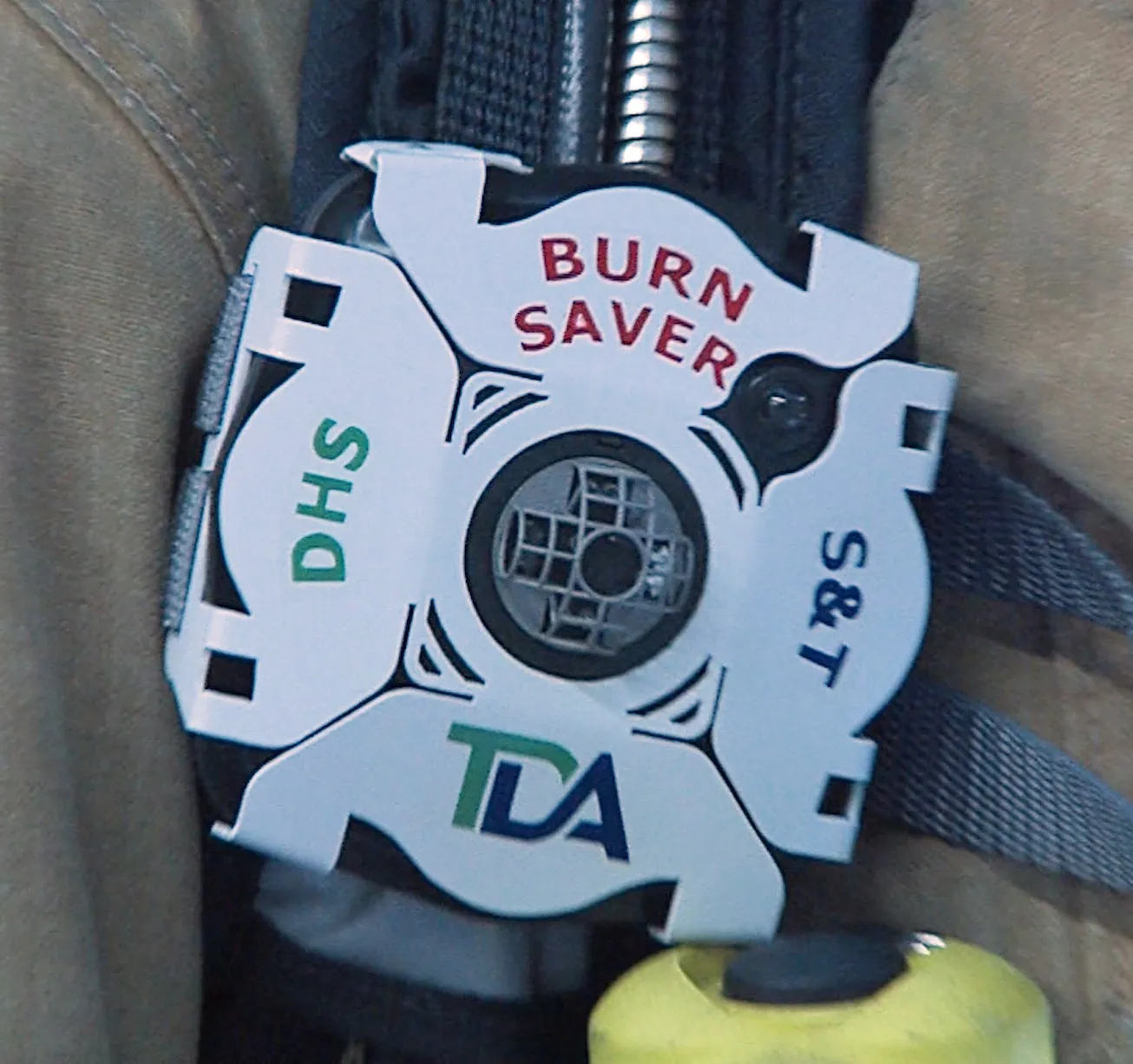When firefighters rush into burning buildings, they know the thermal environment may change in a matter of seconds, exposing them to potentially lethal temperatures. Burn Saver is a body-worn technology that continuously monitors thermal conditions and warns firefighters when those conditions become threatening. Initially funded under the Department of Homeland Security (DHS) Small Business Innovation Research program, Burn Saver was developed by TDA Research Inc. in collaboration with the DHS Science and Technology Directorate (S&T).
“Burn Saver is a device S&T developed to give first responders an early warning when they are in a thermal environment that may cause extreme damage to their personal protective equipment (PPE),” explained S&T Program Manager Bill Deso. In high temperatures, the self-contained breathing apparatus (SCBA) face piece can “craze” – a bubbling effect that limits visibility – or, in extreme temperatures, melt.
Burn Saver, which originated under the DHS Small Business Innovation Research program, is a small, lightweight, battery-powered device featuring sensors contained in a thermoplastic case that can be mounted on a firefighter’s SCBA straps. These sensors monitor the temperature and heat flux of the fireground environment and calculate the amount of time responders have before conditions will damage their SCBA face piece, putting them at extreme risk. Burn Saver activates an alert when it calculates that a firefighter has 45 seconds remaining before the fireground environment begins to damage their face piece, allowing them time to continue fighting the fire at a safer location or exit the unsafe conditions completely.
Traditionally, firefighters rely on their own senses – high heat to their ears, for example – to determine when the fireground was becoming excessively hot. However, as improvements to their PPE head protection have been made, firefighters are no longer able to feel the heat on their ears and can find themselves quickly exposed to dangerous thermal levels.
“This technology addresses something that is very important,” said Lisa Pine, Training and Safety Officer with the Colorado Division of Fire Prevention and Control. “As our PPE improves and gets more advanced, we are able to spend more time in hotter conditions. The weakest part of our ensemble is our face piece, so having the Burn Saver to help us prevent that failure is very important.”
Watch Burn Saver Video Now!
 Pine was one of five firefighters who participated in a recent Operational Field Assessment (OFA) of the Burn Saver at the National Fire Academy in Emmitsburg, Maryland. During the exercise, designed and led by S&T’s National Urban Security Technology Laboratory (NUSTL), firefighters wore the device while conducting various operations to assess its ruggedness and potential effect on mobility and range of motion.
Pine was one of five firefighters who participated in a recent Operational Field Assessment (OFA) of the Burn Saver at the National Fire Academy in Emmitsburg, Maryland. During the exercise, designed and led by S&T’s National Urban Security Technology Laboratory (NUSTL), firefighters wore the device while conducting various operations to assess its ruggedness and potential effect on mobility and range of motion.
“NUSTL led the responders through a series of operational scenarios that required arm and shoulder motion, such as carrying a high-rise pack fire hose and using a sledge hammer, as well as a search and rescue activity that involved crawling through a previously burned structure containing the scorched remains of household furnishings,” explained NUSTL’s Gladys Klemic.
“We use simulated fire scenarios that involve essential job tasks tailored to the technology while ensuring safety. The Burn Saver warning light was remotely activated during the search and rescue mission. In this way, firefighters had the opportunity to provide feedback on the effectiveness of the visual alert without exposing them to a live fire environment,” Klemic explained.
After the operational activities, a controlled burn was performed that generated smoke and dynamic temperature fluctuations inside a burn room. The Burn Saver was mounted on a stand while a video camera focused on the device and evaluators observed from a safe distance. The evaluators were able to observe the Burn Saver light alert through the doorway and experience simultaneous alerts generated at a command center display.
The Burn Saver Operational Field Assessment Report is available for use; download it today!
Keep up with S&T’s work related to first responder personal protective equipment on our website and follow S&T on Twitter, LinkedIn and Facebook. Submit questions to first.responder@hq.dhs.gov.
Caption:
First Responders test the Burn Saver device during an operational field exercise.
